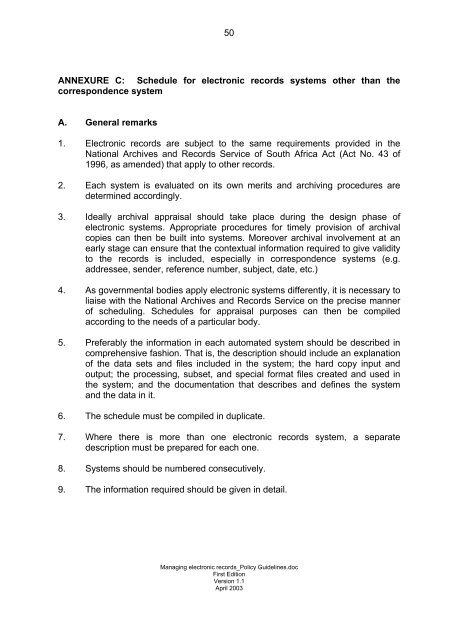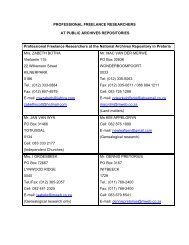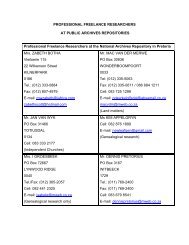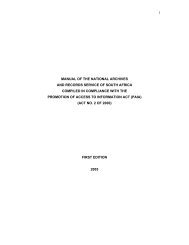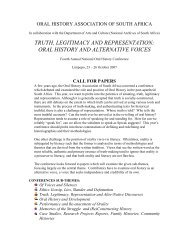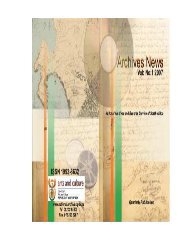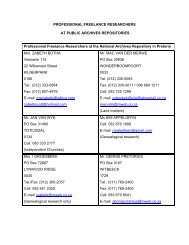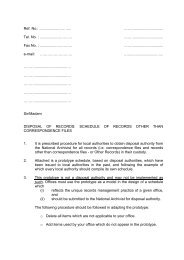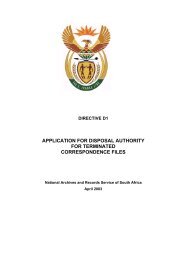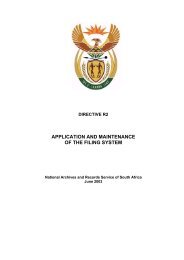managing electronic records in governmental bodies - National ...
managing electronic records in governmental bodies - National ...
managing electronic records in governmental bodies - National ...
You also want an ePaper? Increase the reach of your titles
YUMPU automatically turns print PDFs into web optimized ePapers that Google loves.
50<br />
ANNEXURE C: Schedule for <strong>electronic</strong> <strong>records</strong> systems other than the<br />
correspondence system<br />
A. General remarks<br />
1. Electronic <strong>records</strong> are subject to the same requirements provided <strong>in</strong> the<br />
<strong>National</strong> Archives and Records Service of South Africa Act (Act No. 43 of<br />
1996, as amended) that apply to other <strong>records</strong>.<br />
2. Each system is evaluated on its own merits and archiv<strong>in</strong>g procedures are<br />
determ<strong>in</strong>ed accord<strong>in</strong>gly.<br />
3. Ideally archival appraisal should take place dur<strong>in</strong>g the design phase of<br />
<strong>electronic</strong> systems. Appropriate procedures for timely provision of archival<br />
copies can then be built <strong>in</strong>to systems. Moreover archival <strong>in</strong>volvement at an<br />
early stage can ensure that the contextual <strong>in</strong>formation required to give validity<br />
to the <strong>records</strong> is <strong>in</strong>cluded, especially <strong>in</strong> correspondence systems (e.g.<br />
addressee, sender, reference number, subject, date, etc.)<br />
4. As <strong>governmental</strong> <strong>bodies</strong> apply <strong>electronic</strong> systems differently, it is necessary to<br />
liaise with the <strong>National</strong> Archives and Records Service on the precise manner<br />
of schedul<strong>in</strong>g. Schedules for appraisal purposes can then be compiled<br />
accord<strong>in</strong>g to the needs of a particular body.<br />
5. Preferably the <strong>in</strong>formation <strong>in</strong> each automated system should be described <strong>in</strong><br />
comprehensive fashion. That is, the description should <strong>in</strong>clude an explanation<br />
of the data sets and files <strong>in</strong>cluded <strong>in</strong> the system; the hard copy <strong>in</strong>put and<br />
output; the process<strong>in</strong>g, subset, and special format files created and used <strong>in</strong><br />
the system; and the documentation that describes and def<strong>in</strong>es the system<br />
and the data <strong>in</strong> it.<br />
6. The schedule must be compiled <strong>in</strong> duplicate.<br />
7. Where there is more than one <strong>electronic</strong> <strong>records</strong> system, a separate<br />
description must be prepared for each one.<br />
8. Systems should be numbered consecutively.<br />
9. The <strong>in</strong>formation required should be given <strong>in</strong> detail.<br />
Manag<strong>in</strong>g <strong>electronic</strong> <strong>records</strong>_Policy Guidel<strong>in</strong>es.doc<br />
First Edition<br />
Version 1.1<br />
April 2003


